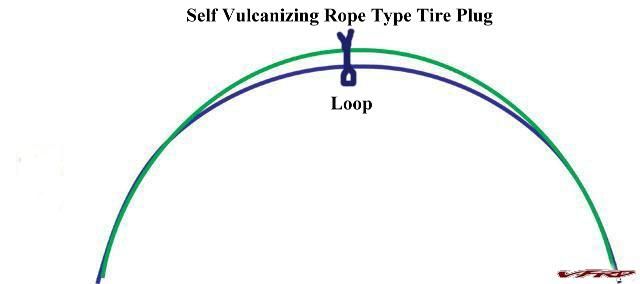THE CHOICE
The choice is yours but I'd start plugging because there is mounting
evidence that plugged tires work and are safe... I have yet to note
anyone armed with first hand knowledge to the contrary...
REPAIRS
Minor tire repair is limited to an area of three quarters of the
normal section width. The maximum diameter of penetration damage
and/or cracking at the base of the injury should be no greater than
3mm. The repair patches must not overlap.
For permanent repair,it is only recommended that small punctures
restricted to the tread area be repaired, using a rope type plug. The
current condition of a tire is important in determining whether a tire
is suitable for repair. Some damage limits include: if the tire has
reached its minimum tread depth as indicated by the TWI (tire wear
indicator); ply separation, separation of inner liner and or cutting
of ply cords by penetrating object; brittle or cracked rubber caused
by exhaust heat; broken or bent bead wire, damaged bead zone; damage
caused by under-inflation; softening or swelling of rubber due to oil
or chemical attack; punctures too close together; damage or previous
repair of a puncture outside of area specified for suitable repair.
MY EXPERIENCES
My screwed Rennsport... boo hoo...
My plugged Rennsport that covered 2K miles and not in moderation
either... it's seen over a 140 mph more than once...
Inside the Rennsport for proof that the rope type plugs stay intact
whereas my mushroom type plug started to come unstuck...
You can see by the diagram that Safety Seal plugs that are installed
properly establish an mushroom shape inside the carcass that holds
fast under pressure... you'd have more luck pushing the plug inside
carcass than you'll ever have it pop out under pressure...
Self Vulcanizing Ropes are convenient to buy and convenient to install
for the Do-It-Yourself owner unable to locate a shop to assume the liability
of a inside Combi Plug for such little profit...
3 Steps on the rode again Self Vulcanizing Ropes...
Rope1) Ream hole with tool provided in the kit found at any parts store
Rope2) Insert rope with tool provided in the kit and trim excess
Rope3) Inflate tire to proper PSI
I don't recommend the inside Combi / mushroom type plugs because
I discovered that the inside patch is solely dependent on a bond
between a plug company's material and the tire manufacture's rubber
compound... that's a crap shoot the two chemical compounds are
compatible enough to hold a bond when the rubber is stationary and at
room temperature... but tires are elastic bodies designed to flex from
completely round to completely flat at every rotation... every
rotation builds heat that works against that bond... every rotation
flexes that mushroom patch from round to flat that works against that
bond.... so we have heat coupled with flex working against the two
competing chemical bonds from being as consistence as a self
vulcanizing rope plug installed from the outside..
7 difficult steps for a due-it-yourself or for a shop to install an inside Combi
Plug whereas the Self Vulcanizing Ropes are convenient to buy and
convenient to install for the Do-It-Yourself owner unable to locate a shop to
assume the liability of a inside Combi Plug for such little profit...
3 Steps on the rode again Self Vulcanizing Ropes...
Rope1) Ream hole with tool provided in the kit found at any parts store
Rope2) Insert rope with tool provided in the kit and trim excess
Rope3) Inflate tire to proper PSI
7 Steps in the shop for a inside Combi Plug...
Combi1) remove wheel from bike
Combi2) remove tire from wheel
Combi3) prepare carcass in accordance to instructions and flush with special cleaner.
Combi4) Insert combi and employ pliers to pull it through, employ pizza roller to press patch flat, trim excess
Combi5) Install tire on wheel
Combi6) Install wheel on bike
Combi7) Inflate tire to proper PSI
Inside Combi Plug...










